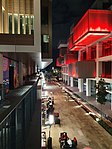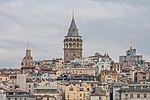Karaköy Pier

Karaköy Pier (Turkish: Karaköy iskelesi) is a ferry landing on the Golden Horn in Beyoğlu, Istanbul. Located along Rıhtım Avenue, just east of the Galata Bridge, Şehir Hatları operates many ferries from Karaköy to Kadıköy, Bostancı, Üsküdar and to piers along the Golden Horn, as far west as Eyüp. Karaköy pier first opened in 1959, replacing an older pier on the Galata Bridge, and has been rebuilt three times since. It is located on the southern shore of the historic Galata neighborhood, known today as Karaköy. Connections to the historic Tünel funicular railway, Istanbul Tram and IETT city bus service is available, as well as connection to private Turyol ferry service at the nearby Turyol pier on the west side of the Galata Bridge.
Excerpt from the Wikipedia article Karaköy Pier (License: CC BY-SA 3.0, Authors, Images).Karaköy Pier
Rıhtım Caddesi,
Geographical coordinates (GPS) Address Nearby Places Show on map
Geographical coordinates (GPS)
| Latitude | Longitude |
|---|---|
| N 41.0217 ° | E 28.9767 ° |
Address
Karaköy İskelesi
Rıhtım Caddesi
34425 (Kemankeş Karamustafa Paşa Mahallesi)
Türkiye
Open on Google Maps







